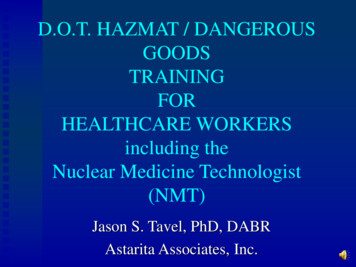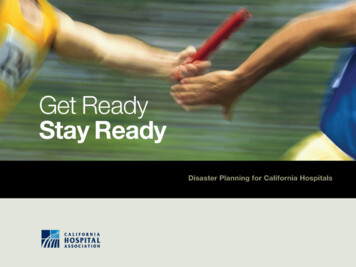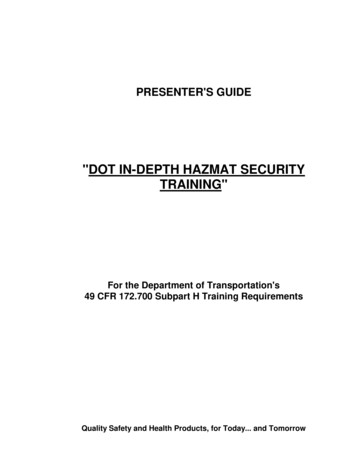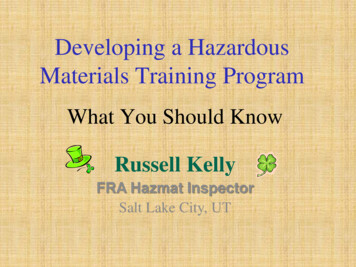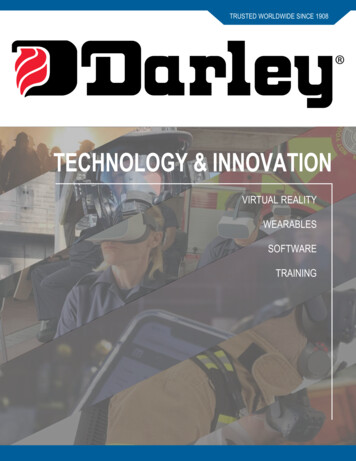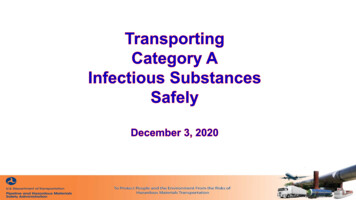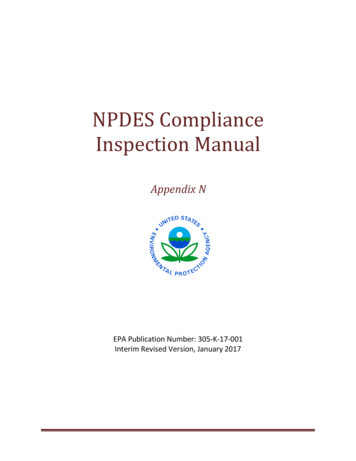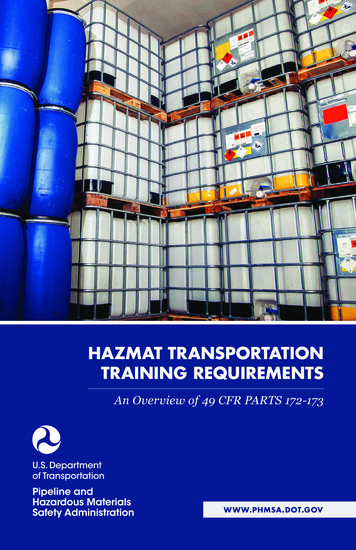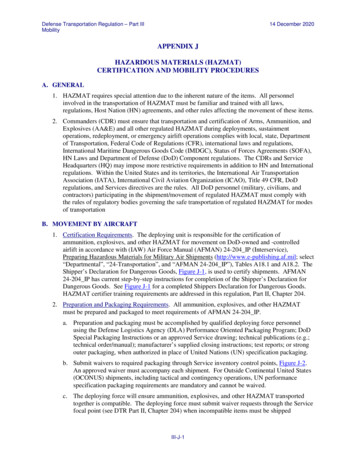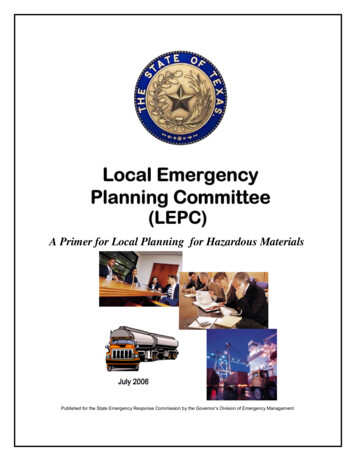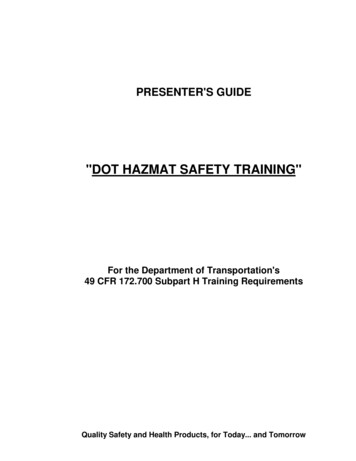
Transcription
PRESENTER'S GUIDE"DOT HAZMAT SAFETY TRAINING"For the Department of Transportation's49 CFR 172.700 Subpart H Training RequirementsQuality Safety and Health Products, for Today. and Tomorrow
OUTLINE OF MAJOR PROGRAM POINTS
OUTLINE OF MAJOR PROGRAM POINTSThe following outline summarizes the major points of information presentedin the program. The outline can be used to review the program beforeconducting a classroom session, as well as in preparing to lead a classdiscussion about the program. Many different types of hazardous materials are usedin business every day. They:— Heat our buildings.— Help us to maintain the equipment we use.— Play important roles in many manufacturingprocesses. But if they aren't handled carefully, hazardousmaterials ("HAZMATs") can also create seriousproblems. Leaks and spills of these substances can cause:— Injuries and fatalities— Property damage— Harm to the environment. HAZMATs could also be used by terrorists as weaponsin an attack. These hazards can be controlled by following safeprocedures that have been spelled out in regulationsestablished by the U.S. Department of Transportation(the DOT). Shipping just about any product follows a fairlystandard process:— An order is called in and warehousing "pulls"the product.— The Shipping Department packs it andsends it out.— The product is delivered via land, sea or aircarrier.— It is finally received at its destination.1
It can all be pretty routine, and if something goeswrong it's normally not a huge problem. But when the product that is being transported is ahazardous material, it's especially important to followproper procedures every step of the way.— With HAZMATs, if something goes wrong itcan be a disaster! Highway accidents, train derailments, plane crashesand other mishaps are bad enough when everyday cargois involved.— But whether a HAZMAT incident takes placeon a loading dock or in transit, it can not onlyaffect the people who are directly involvedin the event, but also the surroundingcommunity and environment, sometimesfor years to come. It is to prevent hazards like these that the "DOT" hasestablished regulations to help ensure that HAZMATsget where they're going safely.— The rules, included in Title 49 of the Codeof Federal Regulations, Subchapter C, Parts100 to 185, are known as the "HazardousMaterials Regulations", or "HMR". Employers are required to provide employees like youwho handle hazardous materials with training on theseDOT rules.— DOT HAZMAT Safety Training providesthe information you will need to recognizeHAZMATs in your workplace and identify thehazards that are associated with them. The training also discusses:— DOT regulations for transporting HAZMATs.— Procedures for shipping, receiving andstoring them safely.— How to respond quickly and effectively in aHAZMAT emergency.2
To work safely with HAZMATs, you need to be able toidentify them and their hazards as soon as possible.— This helps you to anticipate any problemsthat may arise, and take steps to preventthem. So the Department of Transportation requires allcontainers of hazardous materials, and all vehiclesthat transport them, to display "Hazard Class" labelsand placards.— These let you know, even at a distanceor when they're in motion, that the cargorequires special handling. The Hazardous Materials Regulations specify theshape, size and color of the labels and placards, aswell as the types of information that they need tocommunicate. The most important of these is a material's "HazardClass". The DOT has defined nine of them:— Class 1. explosives.— Class 2. all gases.— Class 3. flammable liquids.— Class 4. flammable solids, including those that arespontaneously combustible and dangerous whenwet.— Class 5. oxidizers and organic peroxides.— Class 6. substances that are poisonous andinfectious.— Class 7. all radioactive materials.— Class 8. corrosives, both liquid and solid. Class 9 is a "miscellaneous" class that includes anyhazardous substance that doesn’t clearly fit into one ofthe other eight categories. DOT Hazard Class labels and placards enable workers,law enforcement personnel and first responders to tellat a glance the hazards that are associated with thematerial that is being transported.3
The DOT's Hazardous Materials Regulations requirethat "Shipping Papers" and emergency responseinformation accompany every HAZMAT shipment. "Shipping Papers" provide a basic description of amaterial, including its "Identification Number" and"Proper Shipping Name".— They must also include its "Hazard Class","Division Number" and “Packing Group”,which indicate the type of hazards thematerial presents, and the degree of dangerthat is associated with the substance. The HMR require the Shipping Papers to presentthe information in this order, with no additionalinformation mixed in.— The papers must also contain a 24-houremergency response telephone number thatcan be used to reach someone who has adetailed knowledge of the material that isbeing transported. HAZMAT shippers must ensure that Shipping Papersare included with all hazardous materials that theysend out.— The HMR requires detailed "emergencyresponse information" to accompany allHAZMAT shipments as well.— It may be included on the Shipping Papers,or can be in a separate document. In addition to a material's basic description, emergencyresponse information should include:— Its immediate health hazards, handlingprecautions, and first aid that should begiven to anyone exposed to it.— Procedures for dealing with spills or leaks.— Details on any risk of fire and explosion, aswell as what to do if the substance starts toburn.4
The DOT requires that the Shipping Papers and theemergency response information travel in the cab ofthe vehicle that is transporting the material. When hazardous materials leak or spill, seconds count.— You need to be able to make informed andeffective decisions ASAP so you can bringthe situation under control. That's why the DOT has compiled technical informationand safety procedures about hazardous materials in aconvenient "Emergency Response Guidebook".— To make it easier and quicker to use, theGuidebook takes advantage of the fact thatmany HAZMATs have similar characteristics.— This is what makes it possible to organizeemergency response actions into an easyto-reference set of "sub-guides". In the event of a HAZMAT incident, you look up thematerial that’s involved and are pointed to the "subguide" that contains the response information youneed. The information in the Guidebook is divided into fourcolor-coded sections. The first two help you to identify the correct "subguide" for the material in question.— If you know the HAZMAT's four-digit“chemical identification number”, you canlook it up numerically in the Guidebook'syellow section.— You can use the blue pages to look it upalphabetically by its Proper Shipping Name. Both sections provide you with the number of theappropriate "sub-guide", which you can then findin the orange pages.— The orange section describes theemergency actions that should be taken.5
The green pages in the Guidebook provide informationon how to isolate a spill and limit people’s exposure tothe hazardous material that has been released. Remember that important information about anyhazardous material can also be found on its SafetyData Sheet ("SDS"). Among other information, theSDS will tell you about:— The material's health hazards.— The protective measures you should usewhen handling it.— What type of first aid should be given tosomeone who has been exposed to it. Shipping and receiving are where you are most likely toget "hands on" with HAZMATs that are "in transit".— The DOT's Hazardous Materials Regulationsprovide a number of safe work practices foryou to follow. HAZMAT shipping safety begins with accuratelydescribing the hazardous material that is beingtransported in the Shipping Papers that willaccompany it, then marking and labelling thepackage accordingly.— This provides critical technical and safetyinformation for the people that will handlethe shipment "down the line". You should make sure that a HAZMAT's container,packaging and labelling are all in good condition.— Never pack or send out containers that havebeen damaged or have labels that are tornor illegible.— Only use packaging that has been approved bythe DOT for that particular material. Always handle hazardous materials with care.— Pay attention to markings such as "ThisEnd Up" and "Do Not Stack".6
Whatever vehicle will be used to transport the materialshould be carefully inspected to verify that it's in goodcondition and properly placarded.— Make sure Shipping Papers and emergencyresponse information accompany everyshipment of hazardous materials that yousend out. When hazardous materials shipments arrive at yourfacility, take a good look before you accept them. You should always reject any packages that:— Arrive without accurate Shipping Papers.— Are improperly marked or labeled.— Have been damaged in any way. Do not handle any HAZMAT until you have determinedthe identity of the material and its hazards. Be sure to:— Follow any special precautions that thesubstance requires.— Wear the appropriate personal protectiveequipment while handling it.— Note what type of first aid should be given tosomeone who is exposed to the substance. If you are going to be storing a hazardous material forany length of time, you should determine:— Whether it has any special requirementsregarding the temperature, humidity or lightexposure in the storage area.— If it should be stored separate from anyother materials. This information can be found in the documentationthat accompanies the shipment, as well as on its SDS. Even when we do our best to follow safe workpractices when we're working with hazardousmaterials, things can still go wrong.— Events such as hurricanes, wildfires andearthquakes, are completely beyond ourcontrol, but we still need to be able torespond to them effectively.7
This is why facilities like yours are required to create awritten Emergency Action Plan that describes exactlywhat ought to be done in different types of crisissituations including a HAZMAT emergency. You should be aware of your role in the Plan and mayalready have received training in what to do and whento do it.— Take the time now to familiarize yourselfwith the Emergency Action Plan.— It's available to all employees.— If you have any questions about your partin the Plan, talk to your supervisor. If an emergency does occur, follow the Plan. Do nottry to improvise on the spur of the moment. During a HAZMAT incident, people may be exposedto harmful substances.— In most cases, a short-term exposure willresult in a sudden reaction, such as a rashor burn, but will cause no lasting healthproblems. However, the more hazardous the material, and thelonger the "duration of exposure", the greater thechances of experiencing more severe health effects. Another concern during a HAZMAT emergency is thepotential contamination of the environment outsideyour facility.— This can happen very quickly if liquidHAZMATs spill into an outlet like a stormdrain or sewer.— If you see hazardous materials leaking intoany type of drain, alert your supervisor orthe local emergency response personnelimmediately.8
* * * SUMMARY * * * Be aware of DOT HAZMAT regulations and know howthey apply to the work you do. Know the sources of information you can use todetermine the hazards, safety precautions andemergency response procedures for any hazardousmaterial that you work with. Know the safe work practices you should use whenshipping and receiving HAZMATs. Understand the role you play in your facility'sEmergency Action Plan regarding incidents thatinvolve hazardous materials. Hazardous materials require extra care and attentionthroughout the shipping process, but now that youunderstand the risks and know the safety proceduresto follow, you can help ensure that the HAZMATs youwork with will travel trouble-free every day!9
49 CFR 172.700 Subpart H Training Requirements Quality Safety and Health Products, for Today. and Tomorrow. OUTLINE OF MAJOR PROGRAM POINTS. 1 OUTLINE OF MAJOR PROGRAM POINTS The following outline summarizes the major points of information presented in the program. The outline can be used to review the program before
